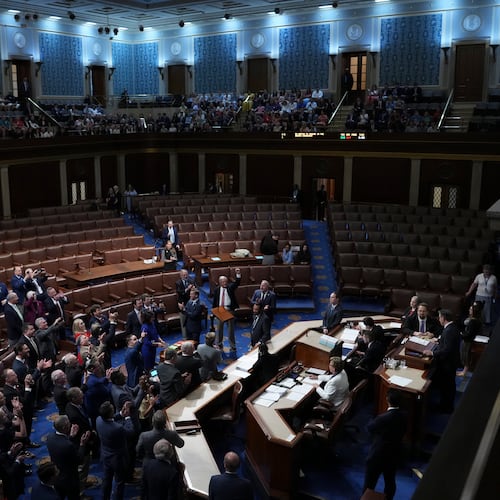The framers of the Constitution envisioned a Supreme Court that would be largely outside politics, protecting Americans' liberties. Alexander Hamilton, for instance, declared that “a limited Constitution … can be preserved in practice no other way than through the … courts of justice.”
Hamilton went on to explain that the courts must “declare all acts contrary to … the Constitution void. Without this, all the reservations of particular rights or privileges would amount to nothing.” That was why the framers created the judiciary – specifically, the Supreme Court – as part of the Constitution: so its authority would have the same origin as the executive and legislative branches of government.
Yet battles over Supreme Court nominations began not long after the Constitution took effect in 1789 and continue to the present day. Most of them weren’t over ideals or constitutional principles like those Hamilton set out, or even concerns about nominees' potential involvement in corruption. Instead, they were about partisan politics.
Credit: contributed
Credit: contributed
The statistical analysis my undergraduate students and I conducted at LaGrange College reveals that many Supreme Court nomination battles were political – and often depended on whether the president’s party also had control of the U.S. Senate.
Early days of the United States
Even George Washington – the very first president of the United States – faced a political conflict over a Supreme Court nominee.
In 1795, Washington nominated South Carolina judge John Rutledge to be the chief justice. Rutledge had actually been an associate justice of the Supreme Court from 1789 to 1791, when he resigned to take a leading role in the courts of his home state, meaning he had already been Senate-confirmed.
But when it came time for the Senate to vote on Rutledge’s reappointment to the court’s most senior position, senators rejected him. After his nomination – but before their vote – Rutledge had spoken out against a treaty with Great Britain, which Washington had supported and the Senate had just ratified.
The Senate’s own history reports, “In turning down Rutledge, the Senate made it clear that an examination of a nominee’s qualifications would include his political views.”
Sometimes, conflict was high: From 1844 through 1861, for instance, twice as many nominees were denied the higher court than were confirmed.
In the modern era, a 1968 filibuster blocked Abe Fortas from becoming the nation’s first Jewish chief justice; Ronald Reagan’s nomination of Robert Bork was rejected in 1987; and Senate Majority Leader Mitch McConnell blocked Barack Obama’s nomination of Merrick Garland in 2016.
Donald Trump’s nominations of Neil Gorsuch and Brett Kavanaugh were also politically charged – as will be that of his newest nominee, Amy Coney Barrett.
Most nominees are approved
In a look at the Supreme Court nomination votes through history, my student researchers and I found that 22.2% of the 153 nominations were not confirmed.
From 1987 to the present, 21.4% of nominees were voted down, denied a vote or a hearing, forced to withdraw under pressure, filibustered or otherwise denied a spot on the Supreme Court. That’s not much higher than the average rate of Supreme Court rejections across the nation’s history.
From 1968 to 2019, 26.9% were rejected or otherwise cast out, including Fortas' 1968 failed promotion. There is nothing unusually partisan about the current era. It’s generally business as usual for both parties.
A key factor is politics
Our analysis included 119 confirmations of a Supreme Court nomination: 114 justices have served, and four associate justices – Edward White, Harlan Stone, Charles Hughes and William Rehnquist – accepted nominations to be chief justice, requiring a new hearing. One justice, Edwin Stanton, was confirmed in 1869 but died before taking office.
Of these successful nominations, 85.7% occurred when the presidency and the Senate were controlled by the same political party.
When different parties control the White House and the Senate, it’s much tougher to confirm a nominee, no matter how qualified or honest he or she may be. Less than half of all nominees to the highest court survive the partisan confirmation battles when the president’s party didn’t control the U.S. Senate.
That fits with research done by political scientists Charles R. Shipan and Megan L. Shannon, who found that “the duration of the confirmation process increases as the ideological distance between the president and the Senate increases.”
Most recently, this happened in 2016, when Democratic President Barack Obama nominated appellate judge Merrick Garland to the Supreme Court. Republicans like Utah Sen. Orrin Hatch even cited Garland as a good choice who could get confirmed. But Republicans controlled the Senate and refused to give him a hearing. Senate Majority Leader Mitch McConnell claimed that the American people – through their approaching presidential vote – should have a say in the Supreme Court nomination.
But when Ginsburg’s death created the exact same scenario in 2020, McConnell promised a swift vote for any nominee the Republican president might present.
In openly politicizing the Supreme Court, McConnell defies the Founding Fathers but fits neatly into the historical trend. A qualified nominee from a president of an opposing party struggles to make headway, but anyone proposed by a president of the same party can expect a rapid vote.
John A. Tures is professor of political science at LaGrange College. This piece originally appeared in The Conversation, a nonprofit news source dedicated to unlocking ideas from academia for the public.
About the Author
Keep Reading
The Latest
Featured




